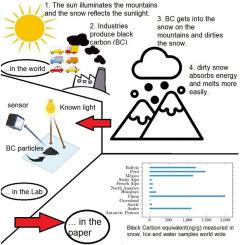Concentration of Black Carbon (BCe) in snow, glacier ice, and glacier water from high mountains in central Mexico and central Andes (Peru and Bolivia)
IF 1.5
4区 地球科学
Q3 GEOSCIENCES, MULTIDISCIPLINARY
引用次数: 0
Abstract
We measure the total optical radiative effect of the sediments (light-absorbing particles) present in surface snow (30 cm), glacier ice, and water samples collected at several high mountains: Iztaccíhuatl and Citlaltépetl in central Mexico; Vallunaraju in Cordillera Blanca, Peru; Condoriri, Huayna Potosi, and Ilimani in Cordillera Real, Bolivia, using a light-absorbing method. This method consists of shining a controlled amount of light on a filter that contains the sediments (light-absorbing particles) from the samples. Different types of light-absorbing particles (LAPs) darken snow surfaces, enhancing snowmelt on glaciers and snowfields. LAPs are often a mixture of biotic and abiotic components at the snow surface, yet methods to separate their respective abundance and albedo-reducing effects are lacking. As more sediments are present on the filter, a more significant amount of light is absorbed. It is important to note that this method does not directly measure the content of black carbon (BC) but, in general, of light-absorbing particles (LAP) without distinguishing between them, and it quantifies the content as equivalent to black carbon (BCe). For all the locations, the snow samples present an average of 1400 ng/g BCe; for the water samples, 1100 ng/g BCe; and for the ice samples, 450 ng/g BCe. For all the samples, a minimum of 12 ng/g BCe and a maximum of 2678 ng/g BCe, corresponding to Vallunaraju (Peru) and Iztaccíhuatl (México), respectively, were measured. Finally, we used the NOAA HYSPLIT Model to trace the possible' backward trajectories at the three localities. The concentrations measured in this BCe work are comparable to those reported in other parts of the world.

来自墨西哥中部和安第斯山脉中部(秘鲁和玻利维亚)高山的雪、冰川冰和冰川水中的黑碳(BCe)浓度
我们测量了在几座高山收集的地表积雪(30厘米)、冰川冰和水样中存在的沉积物(吸光粒子)的总光辐射效应:Iztaccíhuatl和墨西哥中部的citlaltsametel;秘鲁科迪勒拉布兰卡的瓦卢纳拉朱;玻利维亚科迪勒拉雷亚的Condoriri, Huayna Potosi和Ilimani使用光吸收方法。这种方法包括将一定量的光照射到含有样品沉积物(吸光颗粒)的滤光片上。不同类型的吸光颗粒(lap)使雪表面变暗,促进冰川和雪原的融雪。雪表面的lap通常是生物和非生物成分的混合物,但缺乏分离其各自丰度和反照率降低效果的方法。随着更多的沉淀物出现在过滤器上,更多的光被吸收。值得注意的是,该方法不直接测量黑碳(BC)的含量,而是在不区分它们的情况下直接测量吸光颗粒(LAP)的含量,并将其量化为等同于黑碳(BCe)的含量。在所有地点,雪样品的平均含量为1400 ng/g BCe;水样为1100 ng/g BCe;冰样品为450ng /g BCe。对所有样品,测量的最小值为12 ng/g BCe,最大值为2678 ng/g BCe,分别对应于Vallunaraju(秘鲁)和Iztaccíhuatl (m xico)。最后,我们利用NOAA HYSPLIT模型对这三个地点可能的“反向轨迹”进行了追踪。在这项BCe工作中测量的浓度与世界其他地区报告的浓度相当。
本文章由计算机程序翻译,如有差异,请以英文原文为准。
求助全文
约1分钟内获得全文
求助全文
来源期刊

Journal of South American Earth Sciences
地学-地球科学综合
CiteScore
3.70
自引率
22.20%
发文量
364
审稿时长
6-12 weeks
期刊介绍:
Papers must have a regional appeal and should present work of more than local significance. Research papers dealing with the regional geology of South American cratons and mobile belts, within the following research fields:
-Economic geology, metallogenesis and hydrocarbon genesis and reservoirs.
-Geophysics, geochemistry, volcanology, igneous and metamorphic petrology.
-Tectonics, neo- and seismotectonics and geodynamic modeling.
-Geomorphology, geological hazards, environmental geology, climate change in America and Antarctica, and soil research.
-Stratigraphy, sedimentology, structure and basin evolution.
-Paleontology, paleoecology, paleoclimatology and Quaternary geology.
New developments in already established regional projects and new initiatives dealing with the geology of the continent will be summarized and presented on a regular basis. Short notes, discussions, book reviews and conference and workshop reports will also be included when relevant.
 求助内容:
求助内容: 应助结果提醒方式:
应助结果提醒方式:


